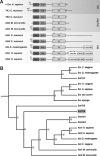Characterization of the Src/Abl hybrid kinase SmTK6 of Schistosoma mansoni
- PMID: 22013071
- PMCID: PMC3234968
- DOI: 10.1074/jbc.M110.210336
Characterization of the Src/Abl hybrid kinase SmTK6 of Schistosoma mansoni
Abstract
Cellular protein-tyrosine kinases play key roles in signal transduction processes in eukaryotes. SmTK4 was the first Syk kinase identified in a parasite and found to be tissue-specifically transcribed in the gonads of adult Schistosoma mansoni. Functional analyses confirmed its role in oogenesis and spermatogenesis. As an SmTK4 upstream binding partner, the cellular protein-tyrosine kinase SmTK6 was isolated from a yeast two-hybrid library. Phylogenetic analyses performed in this study confirmed the first suggestions of a hybrid character of SmTK6. Biochemical studies made in Xenopus oocytes using inhibitors against Src (herbimycin A) and Abl (imatinib) kinases exhibited a biochemical inhibition profile of SmTK6, which was intermediate of Src and Abl kinases. As SmTK6 upstream interaction partners, we identified among others the known Src kinase SmTK3 and the Venus kinase receptor SmVKR1 of S. mansoni by yeast two-hybrid analyses, all of which co-localized in the gonads. Co-immunoprecipitation experiments confirmed interactions between SmTK6 and SmTK3 or SmVKR1. In Xenopus oocytes, it was finally shown that SmVKR1 but also SmTK3 were able to activate SmTK6 enzymatic activity indicating its functions in a receptor tyrosine kinase signal transduction cascade. These results not only demonstrate an intermediate but Src-biased profile of the unusual kinase SmTK6. They also strongly substantiate previous indications for a kinase complex, consisting of a receptor tyrosine kinase, Syk and Src kinases, which has been hypothesized to be involved in proliferation and differentiation processes in the gonads of schistosomes.
Figures





Similar articles
-
The Syk kinase SmTK4 of Schistosoma mansoni is involved in the regulation of spermatogenesis and oogenesis.PLoS Pathog. 2010 Feb 12;6(2):e1000769. doi: 10.1371/journal.ppat.1000769. PLoS Pathog. 2010. PMID: 20169182 Free PMC article.
-
The formin-homology protein SmDia interacts with the Src kinase SmTK and the GTPase SmRho1 in the gonads of Schistosoma mansoni.PLoS One. 2009 Sep 10;4(9):e6998. doi: 10.1371/journal.pone.0006998. PLoS One. 2009. PMID: 19746159 Free PMC article.
-
Identification and first characterization of SmEps8, a potential interaction partner of SmTK3 and SER transcribed in the gonads of Schistosoma mansoni.Exp Parasitol. 2017 Sep;180:55-63. doi: 10.1016/j.exppara.2016.12.002. Epub 2016 Dec 23. Exp Parasitol. 2017. PMID: 28017636
-
Protein tyrosine kinases: autoregulation and small-molecule inhibition.Curr Opin Struct Biol. 2002 Dec;12(6):735-41. doi: 10.1016/s0959-440x(02)00383-4. Curr Opin Struct Biol. 2002. PMID: 12504677 Review.
-
Mutated tyrosine kinases as therapeutic targets in myeloid leukemias.Adv Exp Med Biol. 2003;532:121-40. doi: 10.1007/978-1-4615-0081-0_11. Adv Exp Med Biol. 2003. PMID: 12908554 Review.
Cited by
-
Evidence for Integrin - Venus Kinase Receptor 1 Alliance in the Ovary of Schistosoma mansoni Females Controlling Cell Survival.PLoS Pathog. 2017 Jan 23;13(1):e1006147. doi: 10.1371/journal.ppat.1006147. eCollection 2017 Jan. PLoS Pathog. 2017. PMID: 28114363 Free PMC article.
-
The ABL kinase inhibitor imatinib causes phenotypic changes and lethality in adult Schistosoma japonicum.Parasitol Res. 2019 Mar;118(3):881-890. doi: 10.1007/s00436-019-06224-x. Epub 2019 Feb 7. Parasitol Res. 2019. PMID: 30729300
-
Serum albumin and α-1 acid glycoprotein impede the killing of Schistosoma mansoni by the tyrosine kinase inhibitor Imatinib.Int J Parasitol Drugs Drug Resist. 2014 Aug 7;4(3):287-95. doi: 10.1016/j.ijpddr.2014.07.005. eCollection 2014 Dec. Int J Parasitol Drugs Drug Resist. 2014. PMID: 25516839 Free PMC article.
-
The RIO protein kinase-encoding gene Sj-riok-2 is involved in key reproductive processes in Schistosoma japonicum.Parasit Vectors. 2017 Dec 12;10(1):604. doi: 10.1186/s13071-017-2524-7. Parasit Vectors. 2017. PMID: 29233188 Free PMC article.
-
Dual targeting of insulin and venus kinase Receptors of Schistosoma mansoni for novel anti-schistosome therapy.PLoS Negl Trop Dis. 2013 May 16;7(5):e2226. doi: 10.1371/journal.pntd.0002226. Print 2013. PLoS Negl Trop Dis. 2013. PMID: 23696913 Free PMC article.
References
-
- Bromann P. A., Korkaya H., Courtneidge S. A. (2004) Oncogene 23, 7957–7968 - PubMed
-
- Takahashi A., Obata Y., Fukumoto Y., Nakayama Y., Kasahara K., Kuga T., Higashiyama Y., Saito T., Yokoyama K. K., Yamaguchi N. (2009) Exp. Cell Res. 315, 1117–1141 - PubMed
-
- Hubbard S. R., Till J. H. (2000) Annu. Rev. Biochem. 69, 373–398 - PubMed
Publication types
MeSH terms
Substances
Grants and funding
LinkOut - more resources
Full Text Sources
Research Materials
Miscellaneous

